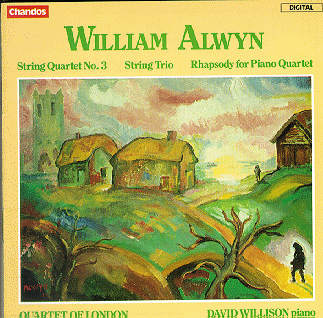THE WILLIAM ALWYN SOCIETY
President: Mary AlwynPatron: Vilem Tausky CBE


Cover Painting: Winter Sunrise by William Alwyn
Rhapsody for Piano Quartet
String Trio
Quartet No. 3
Notes by William Alwyn, © Mary Alwyn
The first movement is constructed on a 12-tone row given here complete but divided into smaller groups in the following three movements. The work begins with a short energetic passage which is immediately followed by a tranquil lilting theme using the whole twelve notes and developed in canon by each instrument in turn. This drifts away on the high upper register of the violin. The rhythmic opening phrase abruptly intervenes but quickly dissolves to a pianissimo ending.
The second movement is a scherzo based on a 5-note group derived from the 12-note row but with a strong tonal centre of C. This short note group is fully developed both in rhythm and melody and reaches a fortissimofortissimo chordal statement which resolves into a complete repeat of the scherzo. There is a short coda in which the movement fades away into the distance.
The third movement - Cavatina - is as indicated by its title a slow movement of song-like character in complete contrast to the Scherzo which precedes it. The mood is quietly reflective and gradually works up to a fortissimo(molto intenso) high above the rapid arpeggio accompaniment of the other two instruments. The movement ends as it began, quietly and reflectively.
The fourth movement plunges into a rhythmic finale. The pace quickens and then changes to a slower and more lyrical mood alternating between quick and slow. This section which ends with sforzando pizzicato chords is followed by a brief coda where an augmented version of the twelve note theme brings the work to a tranquil close.
| All That is about me |
| a radiance - a sigh |
| Time now gathers my winding sheet |
| of syllable and song |
The quartet opens with fortissimo rhythmic chords quickly followed by a leaping theme on the cello which is echoed by the first violin. These two ideas with the addition of a gently brooding second subject are developed throughout the movement.
The second movement, elegiac in character, gradually quickens its pace to a dance-like middle section with high soaring melodies over a pizzicato accompaniment. Eventually the elegiac atmosphere returns and the work ends in a mood of quiet resignation.
| THE PENGUIN COMPLETE GUIDE The Third Quartet is the most important work on this record; like its two predecessors, it is a concentrated and thoughtful piece of very considerable substance, elegiac in feeling. T'he playing of the Quartet of London throughout (and of David Willison in the Rhapsody) is both committed and persuasive. The recording brings the musicians vividly, into one's living-room. |
 Return
to Discography
Return
to Discography